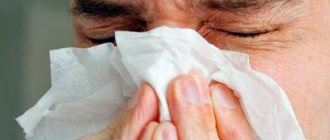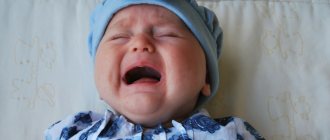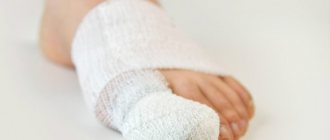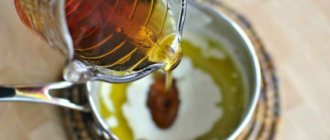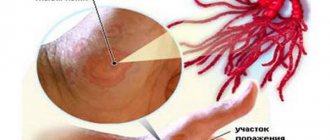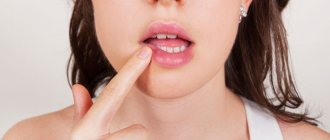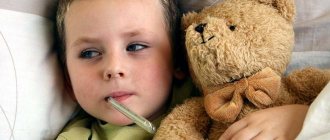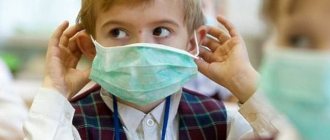One of the common childhood diseases is rhinitis, which is an inflammatory process of the nasal mucosa, or simply a runny nose. Acute rhinitis occurs in both children and adults, but more often in childhood and requires careful treatment.
Typically, a runny nose does not last long or lasts no more than a week, occurs periodically or indicates that the child has a cold. Acute rhinitis in children not only occurs more often than in adults, but is also more severe for a number of reasons:
- early age;
- immature immune system;
- narrow passages in the nose;
- inability to blow your nose well, etc.
This and much more is the reason that acute rhinitis in a child is much more severe. In newborns, the disease affects not only the mucous membrane, but also the entire nasopharynx. In any case, it is important for parents to notice and recognize symptoms as early as possible in order to begin treatment.
Causes
Most often, rhinitis is caused by the virus of the same name - rhinovirus.
Rhinitis in young patients can be an independent disease or one of the symptoms of many infectious diseases: diphtheria, measles, meningococcal infection, parainfluenza, scarlet fever, influenza, etc. Rhinitis can be caused by both viruses and bacteria. Rhinitis of a viral nature occurs more often.
He is called:
- rhinovirus;
- influenza virus;
- rhinosyncytial viruses;
- parainfluenza virus;
- enterovirus;
- adenovirus.
Rhinitis of a bacterial nature is caused by chlamydia and mycoplasma (in rare cases), coccal flora more often (streptococcus, staphylococcus, pneumococcus). Rhinitis can also be caused by a specific pathogen (gonococcus or tuberculosis bacillus) or fungi.
The nasal mucosa is normally an important barrier for microorganisms on their way to the respiratory organs. Viruses and bacteria are enveloped in mucus, which is secreted by special mucosal cells and then removed by epithelial cells.
Under unfavorable conditions (dusty, dry, low air temperature, etc.), the protective functions of the mucous membrane are significantly reduced or completely lost. As a result, viruses freely penetrate the mucosal cells and multiply there, causing cell death. Bacterial flora can also be involved in the process.
The frequent development of rhinitis in children is facilitated by:
- failure of the immune system;
- narrowness of the nasal passages;
- rapid development of swelling of the mucous membrane, further complicating the outflow of mucus;
- inability of small children to blow their nose.
The following predisposing factors contribute to a decrease in the protective function of the mucosa:
- adenoids;
- chronic tonsillitis;
- deviated nasal septum;
- polyps;
- long-term use of vasoconstrictor drops;
- hypothermia;
- foreign body in the nasal cavity;
- diathesis.
The cause of allergic rhinitis is exposure to an allergen (pollen, dust, animal hair, etc.).
Causes
A runny nose can occur under the influence of 2 groups of factors: those associated with local immunity and external irritants.
Violations of local immunity can occur due to certain anatomical features of the nasal cavity. They help protect against the ingress of small foreign particles and dust, which may contain pathogenic bacteria or viruses.
The nasal mucosa is covered with small cilia. They constantly move and push foreign particles out of the cavity. Class A immunoglobulins, which are contained in the nasal mucosa, also fight infection from entering the body. With a decrease in local protective forces, microorganisms that were “dormant” and did not harm the child are activated. Rhinitis develops.
External irritating factors that provoke rhinitis:
- general and local hypothermia;
- nasal injuries, surgical interventions;
- harmful industrial irritants (long stay in a dusty room, near toxic or chemical waste);
- exposure to allergens (fluff, wool, dust).
Symptoms
The incubation period lasts from several hours to 4 days. In the clinical picture of acute rhinitis, there are 3 stages of the process:
- stage of irritation: it is characterized by nasal congestion, swelling, dryness and redness of the mucous membrane in the nasal cavity;
- serous stage: the patency of the nasal passages is significantly impaired, abundant clear liquid discharge from the nose (rhinorrhea), sneezing, lacrimation, and conjunctivitis are noted;
- stage of mucopurulent discharge: by the 5th–7th day, the discharge thickens, acquires a yellow-green color and gradually disappears completely.
When inflammation spreads to the pharynx (rhinopharyngitis), redness in the pharynx, sore throat and cough are noted. Some children with rhinitis have a fever and general malaise. Older children report headaches, deterioration or loss of smell. Due to disrupted nasal breathing, sleep suffers, and the child may refuse to eat. The disease lasts from 7 to 14 days and in uncomplicated cases ends with recovery.
Infectious runny nose and its causes
In some cases, it can be quite difficult to immediately distinguish between infectious and non-infectious runny nose; to do this, you should observe the nasal discharge and the child’s behavior. If it is non-infectious in nature, the mucus will be mostly clear.
Runny nose or rhinitis translated from Greek means inflammation of the nose (rhinos + itis - nose + inflammation). At first, especially young parents, treat their child’s runny nose without much attention. Meanwhile, you need to understand well that it is through the nose that air enters and exits - this is the gateway of the respiratory tract. The nasal cavity is supplied with a large number of nerve endings and is connected to many organs of the body. It is in children, when protective functions are not fully formed, that even a common runny nose can cause serious health problems.
First of all, you need to pay attention to the details of the clinical picture. This will allow the doctor and parents to take into account all changes in the condition and accurately establish the picture of what is happening.
Distinctive features of infectious rhinitis
The infectious type of runny nose has a number of its own characteristic features.
The following symptoms may be observed during infections:
- damage to two nasal passages at once, which manifests itself in dryness, burning, sneezing and sore throat;
- as the disease develops, the child experiences headache, weakness and a lethargic state;
- after 1-2 days, transparent and then yellow or yellow-green nasal discharge begins, and at the same time the body temperature rises to 37.2–37.5 ° C. This stage is the beginning of the acute infectious form;
- further, the nasal mucosa swells, the nose becomes clogged, the sense of smell worsens or disappears, taste sensations change, lacrimation may appear, hearing is impaired and tinnitus appears.
When examining a child, it should be taken into account that infectious runny nose exceeds non-infectious runny nose in the number of cases. Usually, nasal congestion, which precedes inflammation of the nasal mucosa, is caused by airborne viruses. Acute respiratory viral infections also include influenza.
Viruses, entering the nasal mucosa, penetrate the surface cells and form a focus of the disease, which develops almost asymptomatically within 1-3 days. If the epithelium is normal, the “cilia” of the mucosal cells, constantly vibrating, mechanically cleanse the nose of viral infections. In children, the body's protective functions are less developed, so they develop respiratory diseases more often.
Viruses are also characterized by damage to the nasal mucosa and an increase in its permeability, as a result of which conditions arise for the penetration of a bacterial infection. As a result, a runny nose can develop into an acute respiratory disease - acute respiratory infections and occur in a complicated form.
Features of the course of rhinitis in infants
Young children do not yet know how to blow their nose, so rhinitis significantly affects their well-being.
Acute rhinitis in children in the first year of life is most severe, especially in premature babies: their general symptoms are more pronounced and complications develop more often. Narrow nasal passages and a small volume of cavities in the nose contribute to severe disruption or complete cessation of breathing through the nose, even with slight swelling of the mucous membrane.
As a result, sucking is difficult or impossible, and sleep is disturbed. The child is restless and has an elevated temperature; The baby has frequent and shallow breathing through the mouth. It promotes aerophagia (swallowing air), dyspeptic manifestations occur (loose stools, vomiting), the child does not gain or even loses weight.
Long-term respiratory failure contributes to the development of hypoxia (oxygen starvation of tissues). To make breathing easier, the baby tilts its head back - false opisthotonus appears (a convulsive posture with a sharp arching of the back), a tense large fontanel, and sometimes convulsions are noted.
Due to the tendency to generalize inflammation, rhinitis in infants is often accompanied by stomatitis, pharyngitis, otitis, and sometimes even inflammation of the lower respiratory tract - tracheobronchitis and pneumonia. Children often develop dacryocystitis (inflammation of the lacrimal sac) with purulent discharge from the eyes.
Clear runny nose in a baby
The question of how to relieve nasal congestion in a child is asked by almost every parent during the onset of seasonal colds.
No matter how hard you try to protect your child from rhinitis at this time, even strict adherence to preventive measures will not give you a 100% guarantee of preventing ARVI. Treatment of rhinitis in children, as a rule, occurs without any particular difficulties.
The baby’s body already contains the necessary antibodies to successfully fight the virus. A set of additional immune cells is formed if a child has snot, which the body copes with with some success. Treating nasal congestion in a child is not only an uncomfortable process for the baby, but also training the body to resist infections.
The release of clear, odorless mucus from the nasal canals indicates that the baby is just beginning to have rhinitis.
Snot of this nature is much safer for the baby’s body than viscous green secretion. However, parents are not recommended to sit and wait for their child’s clear runny nose to go away on its own. In addition, with infants you should be especially careful in this matter.
Knowing what color the nasal discharge is is necessary in order to choose the right measures to get rid of rhinitis. The main culprits of a green runny nose are harmful bacteria, and the cause of clear discharge is viral or allergic components.
If a child’s rhinitis is caused by a viral attack, you will learn about this from the additional symptoms that accompany any ARVI. If you are unsure of what to do if your baby's nasal congestion occurs, first of all, help your baby get rid of mucus.
Severe congestion will lead to anxiety in the child. Avoid situations where your child’s clear snot dries up in his nose – rinse your baby’s nose with sea salt from time to time.
Before getting rid of a runny nose that has an allergic origin, it is necessary to completely protect the baby from contact with potential allergens. Only after this does it make sense to start giving the baby medications prescribed by the doctor.
Note! A pediatric otolaryngologist will tell you how to treat your child’s runny nose and do preventive rinsing. The latter are an integral part of the plan on how to cure nasal congestion in a child.
Rhinitis in children, accompanied by clear discharge, as well as bouts of sneezing, can act as a kind of reaction of adaptation to the outside world.
To a greater extent, the appearance of such signs is typical of newborns or babies of the first year of life. During adaptation to the world or when the baby is teething, local immune defense drops, which can cause a runny nose.
Whatever the initial reason, how to treat snot in a child should be determined by a specialist. The discontinuation of any medications or the prescription of new ones should also occur only under the supervision of the attending physician.
Features of acute rhinitis in older children
In older age, the course of rhinitis is characterized by rapid development of the process. The first complaints are a burning sensation, tickling in the nose, followed by nasal congestion, lacrimation, sneezing, decreased sense of smell, and headache. Abundant mucous discharge causes irritation of the skin in the area of the upper lip near the nasal passages with the appearance of painful microcracks.
Impaired outflow from the nasal cavity contributes to the development of a bacterial infection, as evidenced by the changed nature of the discharge (cloudy, yellow-green color). By this time, the child’s well-being improves, nasal breathing becomes easier, and recovery begins already on the 7th–8th day.
Treatment of acute viral rhinitis
Viral rhinitis is treated with the same means and methods as common colds. But here you should not count on suppressing the disease in 1-2 days: if a viral infection has occurred, it will develop in the mucous membranes, and the body needs at least 5 days to begin to effectively fight it. Normally, acute viral rhinitis ends in 7-10 days.
The main rule: today there are no means to quickly cure acute rhinitis of a viral nature. No immunomodulators, drugs with interferon, or antiviral drugs can speed up recovery or influence the development of a viral infection in the body. Only the immune system itself suppresses the disease. Exceptions to this rule are acute rhinitis with influenza, for which there are specific drugs (Relenza and Tamiflu), as well as with infectious mononucleosis, which can be treated with antiherpetic drugs. However, all these drugs are very difficult, cause many side effects and are prescribed only when the patient’s life is threatened and severe generalized symptoms are present. They cannot be considered as remedies for viral rhinitis, since rhinitis itself is not a sufficient reason for their prescription and administration.
Dr. Komarovsky: Treatment of ARVI does not require the use of any pharmacological agents at all
At the same time, regular nasal rinsing, moisturizing, and using vasoconstrictor drops before bedtime can reduce the symptoms of the disease and alleviate the patient’s condition. The nose will breathe, there will be no crusts in it, and the temperature will stop rising sooner than without treatment.
When pharyngitis occurs, additional medications are used to relieve sore throat.
Symptoms of chronic rhinitis in children
In children, there are the following types of chronic rhinitis:
- catarrhal;
- hypertrophic (polypous, edematous and fibrous forms);
- vasomotor;
- atrophic;
- allergic.
Chronic catarrhal rhinitis has symptoms similar to the acute form of the disease, but with less severity of symptoms.
Characteristic symptoms:
- almost constant discharge of mucous (or mucopurulent) discharge from the nose;
- nasal congestion (occurring in one or the other nasal passage);
- periodic difficulty in nasal breathing;
- cough when mucus flows into the back of the throat.
Manifestations of chronic hypertrophic rhinitis in children are:
- constant, significant impairment of breathing through the nose;
- headache;
- impaired sense of smell;
- decreased hearing acuity;
- voice change;
- increased fatigue;
- low school performance.
Chronic vasomotor rhinitis most often occurs at school age. It is a consequence of damage to blood vessels and the peripheral nervous system.
It is characterized by:
- paroxysmal runny nose with difficulty breathing through the nose, copious flow of nasal mucus and lacrimation;
- paroxysmal sneezing;
- facial redness;
- excessive sweating,
- attacks of headache;
- frequently occurring paresthesia (numbness, crawling sensation, decreased sensitivity of the skin).
The occurrence of an attack of a runny nose is provoked by some irritant - nervous overstrain, temperature changes, etc.
Chronic atrophic rhinitis occurs rarely in children and is characterized by the development of a fetid runny nose (ozena).
Typical manifestations of ozena:
- formation of rough crusts with an unpleasant odor in the nasal cavity;
- discomforting dry nose;
- nosebleeds;
- difficulty breathing through the nose;
- discharge in the form of viscous mucus that is difficult to clear.
When the atrophic process moves to the bone walls of the nasal cavity, the shape of the nose may change (duck nose deformity).
The clinical features of allergic rhinitis are described on the website in a separate article.
How to treat acute rhinitis if the disease continues to develop?
If the disease has entered the main phase and is not interrupted, it should be treated with the following means and methods:
- The patient continues to drink a lot, he is provoked to sweat, since it is precisely such procedures that make it possible to normalize body temperature without taking antipyretics;
- The nose is washed regularly (5-6 times a day) with saline solution (a teaspoon of salt is dissolved in a liter of water). For one rinse, use a glass of solution and rinse both nostrils. For children under five years of age, the solution is simply dropped into the nose from a pipette. Instead of saline solution, you can use products based on sea water (Aqua Maris, Aqualor, Salin, Humer), but they are more expensive, but provide the same effect. The purpose of these procedures is to flush out excess mucus from the nose, wash away some bacteria and pollutants, and moisturize the mucous membrane;
- In case of complete absence of nasal breathing, or with nasal congestion and sore throat, as well as pain in the ear, the patient needs to instill vasoconstrictor drops into the nose. Children receive special drops based on phenylephrine; there are also drops for infants. It is important to remember that these products cannot be used for more than 5 days in a row. If breathing through the nose does not normalize within this period, you should see a doctor. As an alternative to vasoconstrictors, antihistamine and hormonal drops are used, but this is done only according to strict indications: such drugs cause more side effects and are more expensive;
- If crusts form under the nose, they can be lubricated with various oils and removed after softening.
Nazol Baby - vasoconstrictor drops for infants
Rinsing or moistening the nose must be carried out until complete recovery. This is especially important at the last stage with purulent discharge: if the nasal mucosa is not moistened at this time, thick snot can dry out and form dense thick crusts that are prone to cracking. Usually, already on the seventh or eighth day, the need for these procedures disappears.
It is also useful to read: Hypertrophic rhinitis, its causes and symptoms
On a note
Yogis wash their nose daily, regardless of their health status. This is correct: if you constantly wash away dirt from the mucous membrane, this will help prevent acute rhinitis and other diseases. Yes, and constant hydration of the mucous membranes is useful.
Various drops based on oils (Pinosol, Eucasept, just essential oils) or containing them for acute rhinitis are used only in the last stages and only when crusts appear in the nose. In acute catarrhal rhinitis with an abundance of liquid snot, such medications can disrupt the functioning of the ciliated epithelium and lead to nasal blockage. They are used only to moisturize and soften crusts in the nose, that is, in cases where the rules of treatment were violated and the nose was not moistened. If your nose is constantly washed and instilled with saline during rhinitis, there will be no need for drops with oils.
Video: Doctor Komarovsky tells when you can use vasoconstrictor drops
If, during acute rhinitis, pain appears in the ear, or the patient begins to cough, he must be examined by a doctor. These are signs of complications, many of which can be very dangerous. In adults, it is easier to determine the presence of such complications than in children, especially in infants.
Treatment of rhinitis in children
Most often, treatment of children with rhinitis is carried out at home. Hospitalization may be required:
- if the baby gets sick in the first 6 months of life;
- with high fever and the presence of convulsive readiness;
- in case of severe intoxication or respiratory failure;
- with hemorrhagic syndrome;
- with the development of complications.
Treatment should begin from the first days of illness. It should be comprehensive and include the following components:
- Impact on the pathogen is the use of antiviral drugs and antibacterial agents. Antiviral drugs are effective in the first 3 days of illness. If there is no doubt about the viral nature of rhinitis, Anaferon and Viferon are prescribed. Recombinant interferon-alpha is prescribed for infants; Arbidol is used from the age of 3 (it activates the synthesis of its own interferon).
- For bacterial rhinitis, it is advisable to prescribe an antibiotic taking into account the sensitivity of the isolated microorganism (based on the results of a bacteriological study). Antibiotics are indicated if the child has chronic diseases (tonsillitis, sinusitis, etc.). Local antibiotics can be used: Fusafungin in the form of inhalations, for older children Bioparox aerosol, Isofra spray, Bactroban ointment. Antibacterial drugs are used for no more than 10 days.
- Cleansing (sanitation) of the nasal passages from accumulation of mucus is carried out in young children using a syringe or a special suction.
- Inhalation: the best option is to use a nebulizer. For inhalations, mineral alkaline water (such as Borjomi), soda solution, essential oils, etc. are used. From 2 years old, a child can use a pencil “Golden Star Balm”, “Doctor MOM”,
- Vasoconstrictor nasal drops: in children's practice, Otrivin, Nazivin, Naphazoline, Oxymetazoline, etc. are used. The concentration of the solution and the dosage of the drops depend on the age of the children. Drops cannot be used for longer than 5 (maximum 7) days (!). The drops have no effect on the cause of the disease; they relieve swelling and make the child feel better.
For children under the first 2 years of life, the use of a nasal spray is not recommended due to the risk of respiratory arrest due to a reflex spasm of the glottis of the larynx. Parents should be able to properly place nasal drops. To do this, you need to slightly tilt the child’s head back, drop a drop into one nasal passage and then, lowering his head down, press the wing of the nose against the nasal septum with your finger. Also apply drops into the second nasal passage.
- Symptomatic treatment: antipyretics for high fever (Nurofen, Panadol, Paracetamol, etc.), antitussives and expectorants for coughing (Doctor MOM, chest preparation, Bronchicum elixir, etc.). Children over 3 years old are given distracting procedures: mustard socks (dry mustard powder is poured into socks), mustard foot baths (1 tablespoon of mustard powder is added to 5 liters of water at a temperature of 37–38 0C).
- Physiotherapeutic procedures: UV irradiation (quartz tube), endonasal electrophoresis, ultraphonophoresis, UHF, paraffin treatment.
Treatment of rhinitis can be carried out with homeopathic remedies, but the drug for such treatment and its dosage must be selected by a pediatric homeopath .
With chronic rhinitis, the most important point in treatment is to eliminate the cause that supports inflammation. This can be surgical intervention (removal of polyps, adenoids, resection of a deviated septum, cryodestruction of the mucous membrane during its hypertrophy, etc.).
For vasomotor rhinitis, intranasal blockades are performed (with a solution of novocaine with hydrocortisone), magnetotherapy, laser treatment and other methods are used.
Massage of bioactive points can be used for rhinitis to relieve well-being, reduce the manifestations of the disease and increase the body's defenses. Massage is available for older children. It is carried out with two index fingers. Rotational movements massage symmetrical points in the following sequence:
- points in the recesses of the wings of the nose;
- 2 points on the upper lip under the nostrils;
- at the end of the nose (with one finger);
- on the bridge of the nose on both sides at the corners of the eyes;
- 2 points at the inner edges of the eyebrows;
- on the occipital protuberances on both sides;
- at the base of the second (index) finger, first on the left hand, then on the right.
Massage with a clearly noticeable intensity, for 15 seconds 2-3 times a day for 5-10 days.
Treatment of rhinitis with traditional methods
Herbal remedies can be used if the child does not have allergies.
There are quite a lot of recipes:
- beetroot juice with water (1:1) can be instilled into the nose of infants;
- Garlic crushed in a press should be poured with oil (olive or sunflower), left for 6–12 hours, and 1 drop should be placed in the nose (use for older children, as garlic stings the mucous membrane);
- Kalanchoe juice 2 drops into the nasal passage 2-3 r. in a day;
- aloe juice, diluted with boiled water (in a ratio of 1:10) 2-3 drops per nose;
- inhalation through the nose with decoctions of eucalyptus, chamomile, sage;
- tampons with saline solution (0.5 teaspoon of salt per 100 ml of water) are inserted first into one and then into the other nasal passage to relieve swelling;
- chop the onion and pour in vegetable oil, let it brew for 6–8 hours, strain and lubricate the mucous membrane in the nose.
- If the mucous membrane is dry, after the runny nose has stopped, lubricate the mucous membrane with peach oil, humidify the air in the children's room, and give the child plenty to drink.
Methods and rules of treatment
How to treat rhinitis in a child? The most important thing for successfully getting rid of rhinitis is to regularly clean the nasal passages. To do this, you can use a saline solution or ready-made pharmaceutical products:
- Aqua Maris;
- But salt;
- Movalis;
- Humer.
If you have a stuffy nose without discharge, you can lubricate the nasolabial triangle with ointments:
- Doctor Mom;
- Gevkamen;
- Menthol ointment.
READ ALSO: Inflammatory disease of the pharynx - pharyngitis in children: symptoms and treatment, photos of the throat and effective methods of treatment
To make breathing easier for a baby, you need to use a special bulb with a soft tip to suck out mucus. The nose is washed with herbal decoctions or saline solution. Then make a cotton pad and clean your nose. Do not use cotton swabs to clean your nose.
To reduce swelling and facilitate breathing, vasoconstrictor drops based on oxymetazoline and xylometazoline are used. They do not eliminate the cause of rhinitis, but only alleviate its course. You cannot use such products for more than 5 days in a row. It is effective to drip long-acting anticongestamines (Nazivin, Nazol). Short-acting drops can cause a reverse reaction of the nasal epithelium, and swelling forms again.
How does autism manifest in a child and how to treat the pathology? We have the answer!
Effective remedies for head lice for children are described on this page.
Follow the link and learn how to quickly cure stye on a child’s eye at home.
Antiviral therapy
If rhinitis is accompanied by intoxication, general malaise, weakness, antiviral drugs (Interferon, Arbidol) are additionally administered. But they are effective only if their use is started in the first 3 days from the onset of the disease.
Antibacterial agents
For a runny nose that occurs against the background of chronic tonsillitis, adenoiditis and other infections, antibiotics are required. These are mainly local remedies:
- Isofra;
- Polydex;
- Fusafungitis;
- Bacropan ointment;
- Bioparox.
They should only be prescribed by a doctor. The course of application should not exceed 10 days.
Therapy for allergic rhinitis
Treatment should consist of several stages:
- eliminating the effect of the allergen on the nasal mucosa;
- antihistamine therapy;
- taking aids.
Local remedies for allergic rhinitis:
- Allergodil;
- Vibrocil;
- Histimet.
Learn about the symptoms and treatment of other ENT diseases in children. Read about sinusitis here; about pain in the ear - here; about tracheitis is written in this article. Read about the treatment of green snot in a child here; folk remedies for the runny nose are described here; We have a separate article about the treatment of snot using inhalation with a nebulizer.
Folk remedies and recipes
Rhinitis can be alleviated with the help of herbal medicine. When using folk remedies, you need to take into account their effect on the child’s body (whether they cause allergies or side effects), and the age of the patient.
- For babies under one year old, beetroot juice diluted with water can be instilled into the nose.
- Moisten a cotton swab with sea buckthorn oil and treat the nasal cavity.
- Inhalations with decoctions of sage, chamomile, and eucalyptus are useful. You can add esters of these plants to the water.
- For oral administration, honey and Kalanchoe juice are diluted 1:1. Add ½ teaspoon to mint or St. John's wort tea.
- Grate the onions, pour a glass of vegetable oil. Let it brew for 8 hours. Treat the nasal passages with the resulting product, after moistening a cotton swab.
Forecast
Due to the age-related structural features of the ENT organs, rhinitis in infants is often complicated by acute otitis media.
The outcome of rhinitis in children can be:
- recovery;
- development of complications (otitis media, sinusitis, bronchitis or pneumonia in case of bacterial infection);
- transition to a chronic form with frequent relapses.
It is important to ensure medical supervision during the treatment of acute rhinitis, since unreasonably long-term use of drugs can cause atrophy of the mucous membrane, lead to paresis of blood vessels in the nose, and an allergic reaction.
Drugs for the treatment of runny nose
During treatment of a runny nose, a cough is often associated, as a result of bronchitis. That is why it is always necessary to immediately provide assistance to the child so that the cold does not drag on for 3-4 weeks. A pediatrician will tell you how to treat a runny nose in a child.
The following categories of pharmaceutical drugs are usually used:
- any antiseptics for instillation into the nose that destroy viruses and bacteria in the mucous membrane;
- vasoconstrictor drops to reduce swelling of the mucous membrane;
- moisturizers, in some cases you can use regular burdock oil for instillation, adding 1-2 drops of essential oil of tea tree, eucalyptus or thuja oil;
- drops with antibiotics (as prescribed by a doctor);
- antiallergic drugs for runny nose;
- immunostimulants and immunomodulators in drops, preferably of natural origin;
- homeopathic drops.
When helping your child on your own, be sure to check with your pharmacist about the age at which certain medications can be used. Many drugs are not used to treat children under a certain age.
Summary for parents
There are no minor illnesses in children. In the absence of proper attention to the treatment of a “banal” runny nose, the disease can become chronic and lead to a number of complications.
There is no need to self-medicate your child. Even rhinitis can have a different nature and be treated differently. By following your doctor's prescriptions, you will protect your child from the unpleasant consequences of rhinitis.
The program “Dr. Komarovsky’s School” will tell you about rhinitis in a child, various types of runny nose and methods of treating it:
Runny nose and medications for the common cold - School of Dr. Komarovsky
Causes of children's runny nose
Before even starting home treatment, you need to establish the cause. Understanding the original problem guarantees quick results and no relapse. Note that in the vast majority of cases, children begin to constantly suffer from a runny nose when visiting kindergarten.
There may be several reasons for this condition - infectious and non-infectious. First, parents need to determine whether the runny nose is of a non-infectious nature.
To do this, you need to independently examine the baby.
Etiology
The manifestation of rhinitis in children can be either an independent disease or a complication of various diseases. The most common precursors of the disease are:
- flu;
- measles;
- whooping cough;
- scarlet fever;
- diphtheria;
- diathesis;
- inflammation of the adenoids;
- individual intolerance to vaccination.
Much less often, the disease occurs after atypical diseases caused by viruses or specific bacteria.
In addition to various diseases, the progression of rhinitis can be preceded by:
- foreign body in the child’s nasal cavity;
- hypothermia of the body;
- various nasal injuries;
- allergy.
In infants, rhinitis occurs due to the inability of the latter to independently clean the respiratory tract.
A distinctive feature of the course of prolonged rhinitis in children is its unexpected onset and bilateral spread. In children under two years of age, rhinitis may be accompanied by bouts of fever.
There are several stages of rhinitis:
- dry stage. Duration is only a few hours. Accompanied by general malaise and hyperthermia, headache. There is a feeling of tickling in the nasal cavity;
- second stage. Copious nasal discharge;
- the last stage is characterized by purulent discharge. After this, the symptoms of rhinitis begin to subside.
Treatment of allergic rhinitis
To treat allergic rhinitis, antihistamine nasal drops are usually used, less often - hormonal drops, and only in the presence of generalized symptoms are systemic antihistamines used.
Allergic rhinitis goes away if the nasal mucosa is not affected by allergens. Therefore, you can get rid of the disease if you identify the allergen and take measures to prevent it from getting into your nose - wear a cotton-gauze bandage, move to another area, clean up your apartment.
The only way to eliminate sensitivity to an allergen is specific immunotherapy (SIT) - a rather long and expensive treatment.
Determination of sensitivity to various allergens before immunotherapy
Vasomotor rhinitis cannot be completely cured today. With it, you can correct the symptoms, if exacerbations are caused by allergens, you can protect yourself from them. Sometimes systemic hormonal therapy brings success, but doctors cannot guarantee a guaranteed result in each specific case of this disease.
Find out more about remedies for allergic rhinitis and its treatment...
Varieties
Depending on the causes of occurrence, rhinitis in children is divided into:
Classification of rhinitis
- allergic – the basis is allergic inflammation, accompanied by liquid discharge, itching and frequent sneezing;
- seasonal - easily determined by the cessation of symptoms after a particular season has passed, or there has been a change in weather conditions. However, some irritants in the air can increase the manifestation of unpleasant sensations;
- year-round (prolonged) – the patient can feel relief only when the climate changes;
- infectious – most common in children of primary preschool age. Manifests itself as a complication after an illness;
- acute traumatic rhinitis - begins after a nasal injury;
- non-allergic rhinitis - includes a whole group of specific rhinitis: medicinal, hormonal, rhinitis of the elderly, occupational rhinitis;
- Posterior rhinitis occurs mainly in children of older preschool age. Inflammation occurs in the nasopharynx area and can involve the tonsils in the process.
How to treat acute rhinitis during pregnancy
Acute rhinitis during pregnancy should be treated using the same methods as those used for other patients. Difficulties arise here only when choosing medications, since some of them may be contraindicated during gestation.
It is also useful to read: Hyperplastic rhinitis: features and main aspects of treatment
In most cases, acute rhinitis can be treated without the use of pharmaceuticals. If you regularly wash your nose and drink plenty of fluids, your breathing will not be completely impaired, but you can tolerate 2-3 days with a partially stuffy nose.
If necessary, Sanorin, Xylene, Otrivin, Nafazol-Hemofarm, Nasonex, Alcedin and some other drops can be used as vasoconstrictors during pregnancy, but only in consultation with the doctor and in the smallest quantities possible. It is justified to use them only before bed, so that a woman can get a good night's sleep with a breathing nose.
Xylene is one of the drops approved for pregnant women for the common cold.
Allergic acute rhinitis during pregnancy requires mandatory consultation with a doctor. If possible, in this case, you need to identify the allergen and eliminate it. If this fails, barrier agents (cotton-gauze bandage, Nazaval) and only in exceptional cases - antihistamine nasal drops can be used.
Main article: Cold drops for pregnant women
Symptoms
The most common and severe acute viral rhinitis occurs in newborns, in particular in children born prematurely and in infants. You can easily notice the first symptom in a child - his breathing is rapid and shallow. This entails:
- difficulties when breastfeeding, since there is not enough air to allow the baby to breathe and suckle at the same time;
- sleep disturbance;
- increased body temperature;
- the child is restless all the time;
- loss of body weight.
In very rare cases, rhinitis in newborns is accompanied by fever and excessive sweating.
In children over three years of age, viral rhinitis undergoes a rapid development process. The first symptom is tickling and burning in the nose. Followed by:
- nasal congestion;
- multiple discharge;
- frequent sneezing and tearing;
- the sense of smell decreases;
- pressure appears in the bridge of the nose;
- constant headache;
- irritation of the skin under the nose and the appearance of cracks on the upper lip.
The manifestation of all symptoms of acute viral rhinitis in children disappears after about ten days.
Composition of medicines for the common cold
To treat a runny nose, medications based on the following substances are usually used:
- phenylephrine, recommended for children, but taking into account different doses, from 1 to 4 drops per application, from 6 years old can be used without restrictions, 3-4 drops at a time;
- naphazalina (there may be side effects; they are not used to treat children under 6 years of age);
- imidazoline, used for no more than 10 days;
- sodium deoxyribonucleate, this substance of natural origin is used for treatment from the 1st day of a baby’s life. In many cases, they can quickly cure a child’s runny nose.
Usually, with the right approach, a runny nose in children can be cured in just 2-5 days. Especially when using natural highly effective drugs based on sodium deoxyribonucleate. If you have products in your home medicine cabinet, be sure to check the expiration date and application details. What we treat adults with is often not applicable to children. Many drugs are used only from 6 or 12 years of age.
But we strongly recommend not to self-medicate! Only the attending doctor can select an adequate drug and prescribe the correct dosage based on the individual characteristics of the baby.
Diagnostics
Diagnosing rhinitis in children has no difficulties. It consists of:
- asking parents about their child’s complaints;
- determining the exact time of onset of the first symptoms;
- examination by an ENT specialist;
- For an accurate diagnosis, a blood test is performed;
- A laboratory test of nasal discharge is performed.
To diagnose prolonged viral rhinitis or exclude other inflammations, in addition to the above procedures, additional procedures are performed:
- radiography;
- pharyngoscopy;
- biopsy.
What not to treat acute rhinitis
In addition to distracting procedures, there are many methods and means that are either useless for acute rhinitis or can be harmful, but at the same time they are very popular among the people, and especially among restless mothers and grandmothers. Among these means:
- Interferon-based products - nasal drops (Grippferon), suppositories (Viferon, Genferon), ointment (Viferon), tablets. They are all completely useless. Interferon is not absorbed either in the mucous membranes of the nose, or in the stomach, or in the intestines, and therefore is not able to affect local immunity in the nose, and therefore is not able to fight viruses or bacteria. They work due to the placebo effect;
- Various immunomodulators, including Derinat, IRS-19, Anaferon. Their effectiveness has not been proven; it is impossible to talk about their therapeutic effect;
- Universal antiviral agents - Oscillococcinum, Arbidol, Isoprinosine, Cytovir-3, oxolinic ointment - are also drugs with unproven effectiveness. Usually used as a placebo;
The effectiveness of many antiviral drugs has not been proven, and therefore cannot be considered as medicines
- Numerous newfangled drugs such as Gripout, Neo Angin and others like them, which are common antipyretics with the addition of ascorbic acid and attract attention by their name;
- Inhalations. Steam inhalations for acute rhinitis are contraindicated as they can increase the growth of bacteria. Compressor and nebulizer inhalations for rhinitis are completely useless, since the active substances with them do not settle in the nose, but penetrate into the bronchi and lungs;
- Antibacterial drops. Today it has been experimentally shown that it is impossible to fight bacterial infection with local means - drops, ointments, inhalations. If such an infection exists, it must be suppressed with systemic antibiotics in the form of tablets or injections. Therefore, antibacterial drops are used for acute rhinitis out of ignorance;
- Antibiotics that are tried to be dropped into the nose. This is useless (local antibiotics do not destroy the bacterial infection) and harmful (such therapy can lead to the development of bacterial resistance to the drug and the development of an allergy to the antibiotic in the patient). If the need for antibiotic therapy does arise, only systemic antibiotics will be effective. They are prescribed only by a doctor and only after determining the strain of the bacteria themselves. You can’t just use antibiotics at random: many bacteria that cause rhinitis are resistant to various drugs, and such treatment will give nothing but side effects;
- Breast milk. If they treat acute rhinitis in a small child - under 2 years old - there is a high probability of developing bacterial complications, since breast milk is an excellent breeding ground for the bacteria themselves. Breast milk has no therapeutic effect either in children or adults;
- Honey - for the same reason as breast milk;
- Hydrogen peroxide, urine, onion and garlic juices - these drugs can lead to irritation of the nasal mucosa, but do not have a therapeutic effect. Treatment of acute rhinitis with such folk remedies is dangerous and useless.
In acute rhinitis, antibiotics should not be used to prevent bacterial complications. The principle of action of these drugs is such that they can only destroy an existing infection. If you use them before the infection itself develops, there is a high risk, on the contrary, of provoking bacterial complications.
For example, listen to what Dr. Komarovsky says about the possibility of instilling antibiotics into the nose:
Treatment
It is especially important to begin a timely fight against viral rhinitis for infants in order to prevent the occurrence of complications.
Symptoms and treatment of rhinitis in children
Treatment methods for acute rhinitis in children consist of:
- physical methods that parents can carry out - walks in the fresh air, frequent ventilation of the room, conduct strengthening exercises for children, refusal of adults to smoke and use substances with a pungent odor with the child;
- physiotherapy procedures performed and prescribed by doctors;
- treatment of acute rhinitis with medications. They are usually used in the form of compresses. It is carried out only under medical supervision. The direct effect of drugs on the mucous membrane will help reduce its swelling.
Treatment of infants for rhinitis takes place exclusively under the supervision of medical specialists, and in no case should it be independent.
For children from three years of age, slightly different treatment is carried out, which depends on the stage of development of viral rhinitis. So, the initial stage treatment consists of:
- drinking plenty of hot tea with raspberries or lemon;
- placing mustard plasters on the feet or calf muscles;
- taking hot foot baths, but no more than fifteen minutes;
- medications are used extremely rarely, most often these are nasal drops prescribed by the doctor.
In the second and third stages of rhinitis, treatment is not very different from the first stage of the disease. For drug treatment, antibiotics and vasodilators are prescribed, in the form of nasal drops. It is worth considering that you should not use drops if they do not give the desired effect after ten days of use. You need to consult a doctor for advice and change the treatment.
White snot in a child - what does it mean?
A child with a severe runny nose, during which white discharge comes from the nasal canals, is most likely allergic in nature. If the day before the baby had contact with a strong allergen, then after a while he may develop snot, giving an alarming signal to his parents.
The reason that adults will have to puzzle over how to cure snot in a child may be the flowering of street trees and plants, as well as insufficient air humidity in the room.
If you do not take care in advance to maintain optimal temperature and humidity parameters in the house, then such a question as treating snot in a child will arise before you quite often.
Remedies to combat white runny nose will be aimed at suppressing the allergic reaction, as well as relieving swelling from the mucous membrane of the nasal canals. If you ask a doctor how to cure a runny nose in a child, the first thing he will recommend is antiallergic medications.
Before wondering how to treat an intense runny nose in a baby, you need to understand the reasons for the appearance of white nasal discharge. Depending on what caused the runny nose, the symptoms and treatment of the disease may be different. There are only a few main reasons why a baby may have a white runny nose:
- White snot in a child is infectious. They appear under the influence of viral or bacterial microorganisms. Fungi are also a common cause of this type of runny nose. In this case, the baby will be bothered not only by nasal discharge, but also by an increase in body temperature due to the inflammatory process in the body.
- Your child will have to treat white snot even if the baby has experienced severe nervous strain, has been exposed to toxic components (for example, harmful fumes, cigarette smoke), or the baby has been breathing excessively dry air for some time.
- An allergic reaction that caused a runny nose. In this case, nasal congestion can be removed only with the help of antihistamines and decongestants. They will not only relieve inflammation, but also eliminate the root cause of the disease.
- It also happens that parents are unable to treat a child’s stuffy nose at home. In this case, white discharge from the nose indicates neoplasms in it. For example, the tissues of the nose began to grow, the mucous membrane became thinner, some kind of trauma to the nose occurred - all this can provoke a severe runny nose.
- Rhinitis caused by medications. This happens if the child is given drops or tablets that have a vasoconstrictor effect for a long time. The fact is that drugs of this type can cause addiction in the body. Parental carelessness often results in chronic rhinitis for the baby, accompanied by white discharge.
A white runny nose as such is not a dangerous sign. If the baby does not experience any associated symptoms, no special treatment is required. The doctor can recommend a good remedy to get rid of a runny nose in a child. However, if a child’s thick snot is not treated, the baby may be subject to unpleasant complications:
- transition of the inflammatory process to the nasopharynx and auditory tube;
- the onset of a pathological process in the maxillary sinuses (occurs if a child’s runny nose is not treated in time);
- advancement of infection to the mucous membrane of the throat;
- the beginning of a bacterial inflammatory process.
A loving parent will definitely look for the most effective way to get rid of snot from a baby. Such an unpleasant symptom as a runny nose can cause a lot of discomfort to a small patient. The thick white secretion will interfere with normal sleep, and the baby may lose his appetite.
Due to the fact that the baby constantly breathes through the mouth, the mucous membrane is in a dry state. The leakage of white secretion often leaves behind a mark on the skin in the form of irritation. A specialist will tell you how to rid your child of such a skin reaction. He will also prescribe the best remedy for rashes.
Prevention
In general, preventive measures are aimed at eliminating the influence of possible factors for the onset of the disease. This includes timely treatment of viral diseases in the child, as well as avoiding severe hypothermia of his body.
Preventive measures should be aimed at:
- hardening the child;
- preventing the occurrence of any colds;
- minimize sudden temperature changes between indoors and outdoors;
- perform physical exercises (systematically);
- healthy and nutritious nutrition of a child is the main factor in strengthening his body and preventing diseases;
- ventilate the room where the child is, and it is also important to carry out wet cleaning;
- child sunbathing;
- adhere to basic rules of personal hygiene.

